|
|
| |
|
|
| |
|
|
|
|
| |
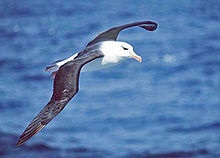 |
| An albatross
hovering over the ocean looking for prey. |
Marine Biology
Marine biology is the study of any living plant or
animal in the sea. Marine biologists are the people who
study it. Like other scientists, marine biologists must
know a lot about the creatures they are studying. They
also must understand how the sea works. The study of how
the sea works is oceanography. There are many kinds of
marine animals and plants to study.
Marine animals include squids, corals, whales and fish.
Marine plants include sea grasses and algae. The Census
of Marine Life was a major project of marine biology. |
|
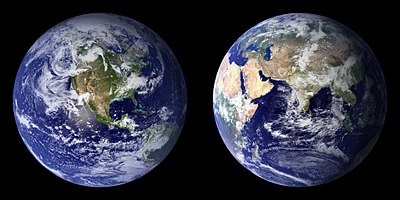 |
| 71 percent of the
Earth's surface is covered by ocean, the home to
marine life. Oceans average nearly four
kilometers in-depth and are fringed with
coastlines that run for 360,000 kilometres. |
Marine life
Microscopic life
As inhabitants of the largest environment on Earth,
microbial marine systems drive changes in every global
system. Microbes are responsible for virtually all the
photosynthesis that occurs in the ocean, as well as the
cycling of carbon, nitrogen, phosphorus and other
nutrients and trace elements.
Microscopic life undersea is incredibly diverse and
still poorly understood. For example, the role of
viruses in marine ecosystems is barely being explored
even in the beginning of the 21st century.
The role of phytoplankton is better understood due to
their critical position as the most numerous primary
producers on Earth. Phytoplankton are categorized into
cyanobacteria (also called blue-green algae/bacteria),
various types of algae (red, green, brown, and
yellow-green), diatoms, dinoflagellates, euglenoids,
coccolithophorids, cryptomonads, chrysophytes,
chlorophytes, prasinophytes, and silicoflagellates.
Zooplankton tend to be somewhat larger, and not all are
microscopic. Many Protozoa are zooplankton, including
dinoflagellates, zooflagellates, foraminiferans, and
radiolarians. Some of these (such as dinoflagellates)
are also phytoplankton; the distinction between plants
and animals often breaks down in very small organisms.
Other zooplankton include cnidarians, ctenophores,
chaetognaths, molluscs, arthropods, urochordates, and
annelids such as polychaetes. Many larger animals begin
their life as zooplankton before they become large
enough to take their familiar forms. Two examples are
fish larvae and sea stars (also called starfish).
Plants and algae
Microscopic algae and plants provide important habitats
for life, sometimes acting as hiding places for larval
forms of larger fish and foraging places for
invertebrates.
Algal life is widespread and very diverse under the
ocean. Microscopic photosynthetic algae contribute a
larger proportion of the world's photosynthetic output
than all the terrestrial forests combined. Most of the
niche occupied by sub plants on land is actually
occupied by macroscopic algae in the ocean, such as
Sargassum and kelp, which are commonly known as seaweeds
that create kelp forests.
Plants that survive in the sea are often found in
shallow waters, such as the seagrasses (examples of
which are eelgrass, Zostera, and turtle grass, Thalassia).
These plants have adapted to the high salinity of the
ocean environment. The intertidal zone is also a good
place to find plant life in the sea, where mangroves or
cordgrass or beach grass might grow. |
|
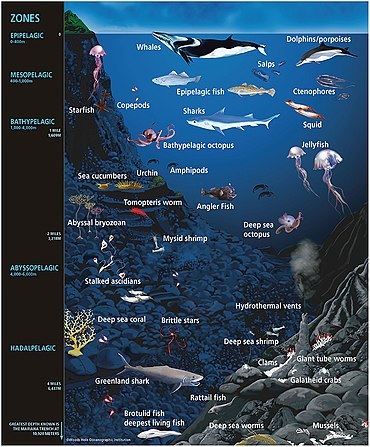 |
| Some representative
ocean animal life (not drawn to scale) within
their approximate depth-defined ecological
habitats. Marine microorganisms exist on the
surfaces and within the tissues and organs of
the diverse life inhabiting the ocean, across
all ocean habitats. |
Invertebrates
As on land, invertebrates make up a huge portion of all
life in the sea. Invertebrate sea life includes Cnidaria
such as jellyfish and sea anemones; Ctenophora; sea
worms including the phyla Platyhelminthes, Nemertea,
Annelida, Sipuncula, Echiura, Chaetognatha, and
Phoronida; Mollusca including shellfish, squid, octopus;
Arthropoda including Chelicerata and Crustacea; Porifera;
Bryozoa; Echinodermata including starfish; and
Urochordata including sea squirts or tunicates.
Invertebrates have no backbone. There are over a million
species.
Fungi
Over 1500 species of fungi are known from marine
environments. These are parasitic on marine algae or
animals, or are saprobes on algae, corals, protozoan
cysts, sea grasses, wood and other substrata, and can
also be found in sea foam. Spores of many species have
special appendages which facilitate attachment to the
substratum. A very diverse range of unusual secondary
metabolites is produced by marine fungi.
Vertebrates
Fish
A reported 33,400 species of fish, including bony and
cartilaginous fish, had been described by 2016, more
than all other vertebrates combined. About 60% of fish
species live in saltwater.
Reptiles
Reptiles which inhabit or frequent the sea include sea
turtles, sea snakes, terrapins, the marine iguana, and
the saltwater crocodile. Most extant marine reptiles,
except for some sea snakes, are oviparous and need to
return to land to lay their eggs. Thus most species,
excepting sea turtles, spend most of their lives on or
near land rather than in the ocean. Despite their marine
adaptations, most sea snakes prefer shallow waters
nearby land, around islands, especially waters that are
somewhat sheltered, as well as near estuaries. Some
extinct marine reptiles, such as ichthyosaurs, evolved
to be viviparous and had no requirement to return to
land.
Birds
Birds adapted to living in the marine environment are
often called seabirds. Examples include albatross,
penguins, gannets, and auks. Although they spend most of
their lives in the ocean, species such as gulls can
often be found thousands of miles inland.
Mammals
There are five main types of marine mammals, namely
cetaceans (toothed whales and baleen whales); sirenians
such as manatees; pinnipeds including seals and the
walrus; sea otters; and the polar bear. All are
air-breathing, and while some such as the sperm whale
can dive for prolonged periods, all must return to the
surface to breathe. |
|
Marine habitats
Marine habitats can be divided into coastal and open
ocean habitats. Coastal habitats are found in the area
that extends from the shoreline to the edge of the
continental shelf. Most marine life is found in coastal
habitats, even though the shelf area occupies only seven
percent of the total ocean area. Open ocean habitats are
found in the deep ocean beyond the edge of the
continental shelf. Alternatively, marine habitats can be
divided into pelagic and demersal habitats. Pelagic
habitats are found near the surface or in the open water
column, away from the bottom of the ocean and affected
by ocean currents, while demersal habitats are near or
on the bottom. Marine habitats can be modified by their
inhabitants. Some marine organisms, like corals, kelp
and sea grasses, are ecosystem engineers which reshape
the marine environment to the point where they create
further habitat for other organisms.
Intertidal and near shore
Intertidal zones, the areas that are close to the shore,
are constantly being exposed and covered by the ocean's
tides. A huge array of life can be found within this
zone. Shore habitats span from the upper intertidal
zones to the area where land vegetation takes
prominence. It can be underwater anywhere from daily to
very infrequently. Many species here are scavengers,
living off of sea life that is washed up on the shore.
Many land animals also make much use of the shore and
intertidal habitats. A subgroup of organisms in this
habitat bores and grinds exposed rock through the
process of bioerosion.
Estuaries
Estuaries are also near shore and influenced by the
tides. An estuary is a partially enclosed coastal body
of water with one or more rivers or streams flowing into
it and with a free connection to the open sea. Estuaries
form a transition zone between freshwater river
environments and saltwater maritime environments. They
are subject both to marine influences—such as tides,
waves, and the influx of saline water—and to riverine
influences—such as flows of fresh water and sediment.
The shifting flows of both sea water and fresh water
provide high levels of nutrients both in the water
column and in sediment, making estuaries among the most
productive natural habitats in the world. |
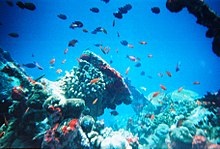 |
| Coral reefs form
complex marine ecosystems with tremendous
biodiversity. |
Reefs
Reefs comprise some of the densest and most diverse
habitats in the world. The best-known types of reefs are
tropical coral reefs which exist in most tropical
waters; however, reefs can also exist in cold water.
Reefs are built up by corals and other
calcium-depositing animals, usually on top of a rocky
outcrop on the ocean floor. Reefs can also grow on other
surfaces, which has made it possible to create
artificial reefs. Coral reefs also support a huge
community of life, including the corals themselves,
their symbiotic zooxanthellae, tropical fish and many
other organisms.
Much attention in marine biology is focused on coral
reefs and the El Niño weather phenomenon. In 1998, coral
reefs experienced the most severe mass bleaching events
on record, when vast expanses of reefs across the world
died because sea surface temperatures rose well above
normal. Some reefs are recovering, but scientists say
that between 50% and 70% of the world's coral reefs are
now endangered and predict that global warming could
exacerbate this trend. |
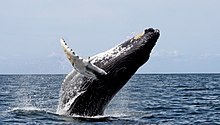 |
| The open ocean is
the area of deep sea beyond the continental
shelves. |
Open ocean
The open ocean is relatively unproductive because of a
lack of nutrients, yet because it is so vast, in total
it produces the most primary productivity. The open
ocean is separated into different zones, and the
different zones each have different ecologies. Zones
which vary according to their depth include the
epipelagic, mesopelagic, bathypelagic, abyssopelagic,
and hadopelagic zones. Zones which vary by the amount of
light they receive include the photic and aphotic zones.
Much of the aphotic zone's energy is supplied by the
open ocean in the form of detritus.
Deep sea and trenches
The deepest recorded oceanic trench measured to date is
the Mariana Trench, near the Philippines, in the Pacific
Ocean at 10,924 m (35,840 ft). At such depths, water
pressure is extreme and there is no sunlight, but some
life still exists. A white flatfish, a shrimp and a
jellyfish were seen by the American crew of the
bathyscaphe Trieste when it dove to the bottom in 1960.
In general, the deep sea is considered to start at the
aphotic zone, the point where sunlight loses its power
of transference through the water. Many life forms that
live at these depths have the ability to create their
own light known as bio-luminescence. Marine life also
flourishes around seamounts that rise from the depths,
where fish and other sea life congregate to spawn and
feed. Hydrothermal vents along the mid-ocean ridge
spreading centers act as oases, as do their opposites,
cold seeps. Such places support unique biomes and many
new microbes and other lifeforms have been discovered at
these locations. |
|
 Kiddle: Marine Biology Kiddle: Marine Biology
Wikipedia: Marine Biology |
|
|
|
|
|
|
|
|
|
|
|
|
|
|
|
|
Search Fun Easy English |
|
|
|
|
|
|
|
|
|
|
|
|
|
|
|
About
Contact
Copyright
Resources
Site Map |